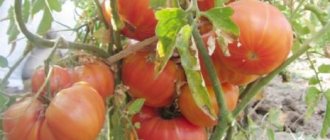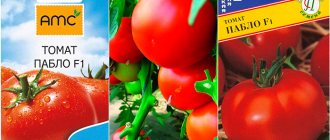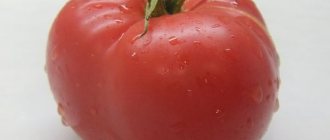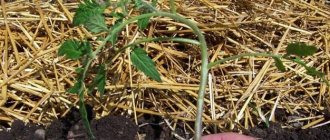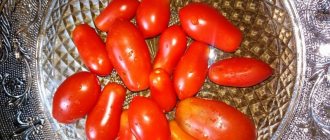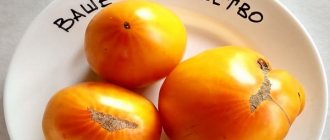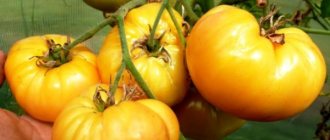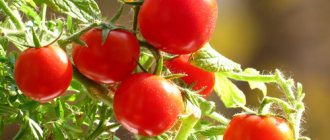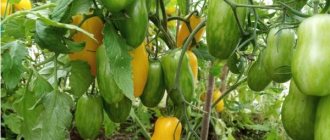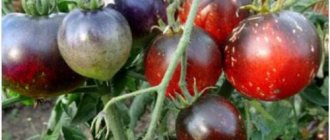If a tomato is green, it does not necessarily mean it is unripe. It could also be a representative of a green-fruited variety, such as Chile Verde, which produces tasty and sweet tomatoes with an unusual shade.
| Height | Landing location | Ripening time | Fruit color | Fruit size | Origin | Fruit shape |
| Tall | Greenhouse, Open ground | Mid-season | Greens | Average | Variety | Plum-shaped or oval |
characteristics and description of the variety, cultivation with photos
Chile tomatoes attract gardeners with their unusual nature. Even ripe fruits have an emerald color. They are never red. However, the taste is not inferior to other varieties. They have juicy flesh and a pleasant classic taste.
What are Chile tomatoes?
Characteristics of the variety:
- The variety belongs to mid-season tomatoes.
- Growing is possible in greenhouses or open ground in regions with warm climates.
- The plant is indeterminate, tall.
- The bush can reach a height of more than 2 m. It is quite large and powerful and can take up a lot of space in the garden bed.
- The bushes have an average number of leaves. Leaves are normal size and green.
- The brushes are complex and branched. 1 can ripen 6-9 fruits at the same time.
Chili tomato should be formed into 1-3 stems. On each of them, gardeners should leave no more than 6 brushes. Otherwise, yields may be lower than planned. It is better to remove side shoots from the bush.
The plant grows very quickly. For better fruit quality, it is necessary to constantly remove shoots and feed the bushes.
Chile tomatoes are oval, slightly elongated. They vaguely resemble pepper. Hence the name.
The fruits are shiny. Emerald color. The berries are green in both technical and biological ripeness. As soon as the tomatoes begin to ripen, they develop a slightly noticeable blush of a light golden color.
The pulp is tender, emerald green, sweet. In the center of the tomato it is darker than at the edges. Dessert tomato. The aroma is pleasant, not tart. The weight of 1 fruit is about 80-100 g. They are compact. There are no ribs on the skin. The surface is smooth and dense. Tomatoes don't crack.
Summer residents harvest the first harvest 100 days after the seedlings emerge. New fruits ripen quite quickly. Fresh tomatoes can be harvested for the table every few days. With proper care, you can harvest from 5 to 10 kg of ripe tomatoes from 1 bush. Reviews from some summer residents indicate a yield of 13-15 kg per bush. This is possible thanks to constant feeding.
The main thing with this variety is not to miss ripening. The only drawback of Chile is that it is difficult to determine at first glance when a tomato is fully ripe and ready to eat. Experienced gardeners assure that the golden hue, which is just beginning to be visible, indicates ripening.
The harvest can be consumed fresh and in various salads. The variety is suitable for harvesting for the winter - pickling or canning whole. The small-sized fruits easily fit into jars and look aesthetically pleasing. The fruits are stored well at home. Withstands transportation.
How to grow tomatoes?
According to the method of cultivation, the variety belongs to seedling tomatoes. In order to grow a good harvest, you need to pay due attention to planting seeds. The seeds are soaked for 10-20 minutes in a manganese solution. They are then washed and dried. Next, the grains are germinated in a wet cloth. Planting is carried out in soil as soon as the seeds swell and their first shoots emerge.
Jars with soil are covered with cling film to create a greenhouse effect. In such an environment, sprouts will appear from the soil within 5-7 days. Plants need warmth and light. If there is not enough sunlight, gardeners install lamps above the seedlings. Seedlings need constant watering.
Picking takes place when the sprouts have 3-4 strong leaves. Plants will grow faster in separate pots.
As soon as the soil warms up to +14ºС, spring frosts have passed, and the seedlings can be moved to a permanent place.
The holes are made in well-fertilized, dug soil without weeds and roots. The distance between them should be approximately 40-50 cm. It is recommended to place a mixture of superphosphate and potassium sulfate in each hole. This fertilizer will help the plants take root faster and produce a high-quality harvest.
The plant must be tied to a support so that it develops and grows upward. The support will help hold the brushes on which the fruits ripen.
Bushes are formed into 1-3 stems. There should be no more than 6 brushes. Watering should not be very abundant, only during drought. Irrigation is carried out once a week. The variety does not like large amounts of moisture. If you water it too much, the fruits will absorb water and become too watery. Because of this, they will lose their saturation.
The bushes need to be pinched, shoots and yellowed old leaves removed. This way all the nutrients will be delivered to the fruit. Summer residents should periodically weed tomato beds and loosen them.
Advantages of the variety:
- Fast ripening of fruits.
- Tomatoes are consumed fresh and are also used for winter preparations.
- Does not require careful care.
- Unusual color of ripe fruits.
- Excellent tomato taste.
- Elastic skin that does not crack.
- Keeping quality.
Disadvantages include the need to refine the bush by removing old leaves and new shoots, and the fact that the tomato is not used for growing for sale due to its unusual color, which buyers may mistake for unripeness.
moefermerstvo.ru
Cherry with mustard seeds
Another very interesting recipe is with mustard seeds. Cherries are piquant and spicy. I usually prepare these tomatoes in a half-liter jar. These products are designed for four such jars.
- 1 kg cherry tomatoes;
- 2 teaspoons (topped) mustard seeds;
- 24 peas of allspice;
- 4 things. bay leaf;
- 1 liter of water;
- 100 ml apple cider vinegar (6%);
- 3 teaspoons salt;
- 3 tbsp. spoons of granulated sugar.
- We sterilize jars and lids for preservation.
- Wash the tomatoes well and wipe with a paper towel. We put them in jars.
- Boil water in a kettle, pour in tomatoes. Cover with lids and leave for 20 minutes.
- Pour water from the jars into the pan. Add sugar, salt and vinegar. Heat to a boil.
- Meanwhile, pour 6 peppercorns, 1 bay leaf and half a teaspoon of mustard seeds into the jars. Pour in the hot marinade.
Now you can roll up the lids, turn them over and cover with a warm towel. After a day, transfer to a cool place.
If you are into video recipes, check out this method of pickling cherry tomatoes.
These are the best cherry cherry recipes for the winter, finger-licking, incredibly tasty and beautiful! I wish you successful preparations and a great mood! Bon appetit!
description and characteristics of the variety, cultivation and care with photos
The Chile Verde tomato will appeal to those gardeners who like to plant unusual varieties of tomatoes. It is distinguished from most traditional varieties by the color of ripe fruits.
Characteristics of the Chile Verde variety
The Chile Verde tomato variety is a tall, indeterminate, rare tomato. The bush reaches a height of up to 2 m. The plant grows quickly after planting in a permanent place and takes up a lot of space on the site.
Chile tomatoes begin to ripen 100–105 days after germination. The plant's brush is a complex type, branched. 7–10 fruits ripen on each cyst. The plant is medium leafy.
Tomatoes are suitable for growing in greenhouses and open areas.
The peculiarity of cultivation in a greenhouse is that the tomato is formed into 1–2 stems. And on each one they leave no more than 5 bunches of fruit. Requires removal of side shoots and tying to a vertical support.
Description of tomatoes
Growing tomatoes of this variety is different in that as the fruits ripen they acquire a yellow-green hue. This is what distinguishes Chile Verde from traditional red-fruited tomato varieties. Near the stalk the skin is green, which gradually turns golden.
The shape of the fruit is plum-shaped. The weight of one tomato is 85–120 g. The pulp is juicy and tender. The skin is dense, smooth, without ribbing. It does not crack during ripening and salting. Tomatoes are ideal for canning in their entirety. Productivity is high, up to 5 kg of crop is harvested from one bush.
Advantages and disadvantages of growing
Planting Chile Verde tomatoes has its advantages and disadvantages. Among the disadvantages, it is worth noting the need to constantly remove old leaves from the bush. If this is not done, the yield will be lower.
Advantages of the variety:
- The fruits ripen quickly.
- Thick skin, suitable for whole pickling.
- Universal use in cooking.
- Unpretentious in care.
- The tomatoes are sweet and juicy.
Due to the unusual shade of ripe fruits, many gardeners prefer traditional red varieties. But the Chile Verde variety is no worse than other tomatoes.
Features of growing the Chile Verde variety
Growing Chile Verde tomatoes is easy if you pay more attention to planting seedlings and caring for mature bushes. To increase the percentage of germination, the seeds are pre-selected and germinated. It is easy to separate high-quality planting material from low-quality ones. For this, 1 tsp. Dissolve table salt in one glass of water. Pour the seeds into a glass. Those seeds that remain at the bottom are suitable for growing. Planting material that floats is thrown away.
You need to germinate the seeds as follows:
- The seeds are pre-soaked for 15 minutes in a solution of potassium permanganate, then dried.
- Soak the gauze in water and place the seeds in it, cover with another part of the gauze.
- Place the gauze in a saucer and place it in a warm place.
- Periodically, the seeds are sprayed with a spray bottle.
- After 2–3 days, the first sprouts should appear, after which the seeds are planted in the soil.
When the seedlings grow up and the weather is warm outside, they are planted in a permanent place. Before planting, add 40 g of superphosphate mixed with potassium sulfate to each well. The first weeks after planting seedlings in a new place, they are covered with a warm cloth at night.
During fruit formation, the bushes are fed with magnesium sulfate. Attention needs to be paid to watering. Tomatoes do not like excessive humidity. If you water the plants frequently, the fruits will be watery. If it is very hot outside, you need to water the beds once a week. With frequent rains, you can do without watering at all. Periodically, the beds are inspected for the presence of diseases and insects.
dachamechty.ru
Growing seedlings
In open ground, cherry tomatoes are grown through seedlings:
- To do this, from March to the end of April, the seeds are sown in purchased universal soil for tomatoes or in black soil with the addition of sand so that the pH of the soil is neutral.
- , discard empty ones immediately.
- Make furrows, water with warm water, spread out the seeds, cover with a small layer of soil (up to 0.5 cm) and moisten again.
- Place the plantings on a windowsill, well lit by the sun, where the temperature will be 25-28°C.
- After 5-6 days, sprouts will appear.
Regularly moisten the soil and loosen it occasionally so that oxygen can circulate well in the soil. When 3-4 leaves appear, you need to pick the seedlings into pots or cups. If the balcony is warm (temperature above 16-17°C), then the rooted young seedlings can be moved.
Planting cherry tomato seedlings in open ground
From mid-May to mid-June, seedlings are planted in a permanent place, having previously hardened them (during the week, place the seedlings on an open balcony during the day, and bring them back at night). Seedlings are ready for planting in open ground if the stem height is about 30 cm and the number of leaves is within 10 pieces. Loosen the area for growing cherry tomatoes, clear of weeds and raise if the groundwater level is close to the surface. In anticipation of transplanting the seedlings to a permanent location, stop watering.
The distance between plants when planting cherry tomatoes is 70-100 cm. The depth of the holes is equal to an earthen clod. Do not thicken the plantings, this will cause slower growth. Immediately install so that future fruits do not come into contact with the ground and do not break the plant under their own weight. Usually tall varieties of cherry tomatoes, forming a bush into one or two trunks, removing intermediate leaves. Fruiting is simultaneous, occurs after 3 months and lasts until the temperature drops to 8°C. Cherry tomatoes are picked individually or in whole branches, but at absolute ripeness. In this case, it is better not to practice ripening, since the taste of unripe fruits will not be as pronounced.
Cherry tomato seeds are collected only from varietal plants; hybrids do not retain the characteristics of their “parents”. To do this, choose the variety you like and leave the most beautiful fruit, or maybe two, for.
As a rule, these are early-ripening, tall varieties. An average of 16 to 20 fruits can form on a cluster. And its length in some cases reaches one meter. With various colors (yellow, pink, red, orange, green) and shapes (round, elongated, teardrop-shaped), such multi-colored clusters can become a decoration for the garden.
Cherry tomatoes can also be grown on balconies, in flowerpots (since tomato plants are abundantly branched, they definitely need support). They are especially good in hanging flowerpots: drooping shoots, long clusters with small bright red aromatic fruits create the impression of large beads strung against a background of openwork foliage.
For growing in small pots and boxes, you need to choose varieties with a compact bush shape, up to 3040 cm in height. Tomatoes sown in March can bear fruit until the New Year.
Description of the Chile Verde tomato variety, features of cultivation and care
The Chile Verde tomato will appeal to those gardeners who like to plant unusual varieties of tomatoes. It is distinguished from most traditional varieties by the color of ripe fruits.
Characteristics of the Chile Verde variety
The Chile Verde tomato variety is a tall, indeterminate, rare tomato. The bush reaches a height of up to 2 m. The plant grows quickly after planting in a permanent place and takes up a lot of space on the site.
Chile tomatoes begin to ripen 100–105 days after germination. The plant's brush is a complex type, branched. 7–10 fruits ripen on each cyst. The plant is medium leafy.
Tomatoes are suitable for growing in greenhouses and open areas. The peculiarity of cultivation in a greenhouse is that the tomato is formed into 1–2 stems. And on each one they leave no more than 5 bunches of fruit. Requires removal of side shoots and tying to a vertical support.
Description of tomatoes
Growing tomatoes of this variety is different in that as the fruits ripen they acquire a yellow-green hue. This is what distinguishes Chile Verde from traditional red-fruited tomato varieties. Near the stalk the skin is green, which gradually turns golden.
The shape of the fruit is plum-shaped. The weight of one tomato is 85–120 g. The pulp is juicy and tender. The skin is dense, smooth, without ribbing. It does not crack during ripening and salting. Tomatoes are ideal for canning in their entirety. Productivity is high, up to 5 kg of crop is harvested from one bush.
Advantages and disadvantages of growing
Planting Chile Verde tomatoes has its advantages and disadvantages. Among the disadvantages, it is worth noting the need to constantly remove old leaves from the bush. If this is not done, the yield will be lower.
Advantages of the variety:
- The fruits ripen quickly.
- Thick skin, suitable for whole pickling.
- Universal use in cooking.
- Unpretentious in care.
- The tomatoes are sweet and juicy.
Due to the unusual shade of ripe fruits, many gardeners prefer traditional red varieties. But the Chile Verde variety is no worse than other tomatoes.
Features of growing the Chile Verde variety
Growing Chile Verde tomatoes is easy if you pay more attention to planting seedlings and caring for mature bushes. To increase the percentage of germination, the seeds are pre-selected and germinated. It is easy to separate high-quality planting material from low-quality ones. For this, 1 tsp. Dissolve table salt in one glass of water. Pour the seeds into a glass. Those seeds that remain at the bottom are suitable for growing. Planting material that floats is thrown away.
You need to germinate the seeds as follows:
- The seeds are pre-soaked for 15 minutes in a solution of potassium permanganate, then dried.
- Soak the gauze in water and place the seeds in it, cover with another part of the gauze.
- Place the gauze in a saucer and place it in a warm place.
- Periodically, the seeds are sprayed with a spray bottle.
- After 2–3 days, the first sprouts should appear, after which the seeds are planted in the soil.
When the seedlings grow up and the weather is warm outside, they are planted in a permanent place. Before planting, add 40 g of superphosphate mixed with potassium sulfate to each well. The first weeks after planting seedlings in a new place, they are covered with a warm cloth at night.
During fruit formation, the bushes are fed with magnesium sulfate. Attention needs to be paid to watering. Tomatoes do not like excessive humidity. If you water the plants frequently, the fruits will be watery. If it is very hot outside, you need to water the beds once a week. With frequent rains, you can do without watering at all. Periodically, the beds are inspected for the presence of diseases and insects.
xn—-7sbbncec2cn3hzb.xn--p1ai
How to grow tomatoes
Seed preparation
First, the seed is carefully inspected, disposing of seeds that are dark in color, small and with visible damage. Then they are placed in a saline solution to determine emptiness: those that float to the surface are unsuitable for landing. After this, the seeds are disinfected in a weak solution of potassium permanganate for 20 minutes, washed with running water and dried.
Hardening of seeds becomes especially important when growing crops in cold areas. The seed is placed on the bottom shelf of the refrigerator for a day
Then the grains are heated for another day at a temperature of 25°C.
Container and soil
The soil is prepared from garden soil, humus and peat in equal quantities. For ease, add washed river sand. After thoroughly mixing all the components, the soil mixture is poured with a hot solution of potassium permanganate or steamed in the oven at a temperature of 60°C for 10 minutes. Disinfection of prepared soil is necessary, since the soil contains a large number of pathogenic microorganisms that can cause irreparable harm to seedlings.
After the soil has cooled, it is laid out in planting containers, at the bottom of which drainage holes are made in advance. You can plant in a common wooden box or in separate containers, at the bottom of which you place some small pebbles or sawdust.
Seeds are sown to a depth of 1 cm with a distance of 3-4 cm from each other. Sprinkle soil on top, lightly compact and moisten with warm, settled water using a spray bottle. The seeded containers are covered with film to create a greenhouse effect and left in a warm and bright room at a temperature of 25°C. After a week, you can notice the appearance of the first shoots.
Seedling care
When shoots appear, the film is removed and the containers are moved to the windowsill, but not to direct sunlight. The duration of daylight for seedlings is 12 hours. If there is a lack of natural light, add phytolamps.
When two true leaves appear, the seedlings are picked and placed in separate containers. If the seedlings are left in a common container, then the distance between them is increased to 10-13 cm. After picking, the lateral roots grow intensively and the seedlings develop more intensively.
Three weeks before planting in the ground, seedlings are hardened off in the open air for 45 minutes. In subsequent days, the time spent outside is gradually increased to 11 hours. Simultaneously with daytime hardening, the night temperature in the room is reduced to 12°C.
After two months, the seedlings are ready for planting in the ground. Transplantation is carried out when the threat of spring frosts has passed.
Landing
Planting pattern: 45 cm – distance between seedlings, 70 cm – row spacing. For 1 sq. m place no more than four plants.
The beds are chosen in a sunny place, protected from drafts. When planted in a checkerboard pattern, the seedlings do not shade each other and each bush receives a sufficient amount of sunlight.
Holes 20 cm deep are prepared in advance; a little sawdust or ash is placed on their bottom and filled with water. After transplantation, water again with warm, settled water and leave for adaptation for 8-10 days.
Tomato care
After watering, the soil must be loosened and weeds removed. Loosening ensures soil breathability and eliminates ground-borne pests.
To retain moisture in the beds for longer, they are mulched with straw. Peat can also be used as mulch, which additionally enriches the root system with useful substances.
Fertilizing is applied once every two weeks. Fertilize with a full complex of minerals alternately with organic matter. During flowering, they are fertilized mainly with phosphorus substances, and during fruiting, potassium preparations are added to speed up the filling of vegetables.
reviews of tomatoes, description and characteristics of the variety, photos of seeds
If a tomato is green, it does not necessarily mean it is unripe. It could also be a representative of a green-fruited variety, such as Chile Verde, which produces tasty and sweet tomatoes with an unusual shade.
| Height | Landing location | Ripening time | Fruit color | Fruit size | Origin | Fruit shape |
| Tall | Greenhouse, Open ground | Mid-season | Greens | Average | Variety | Plum-shaped or oval |
The content of the article
Description and characteristics of the variety
The Chile Verde tomato has an indeterminate bush, growing up to 1.8-2 m. Leaves cover it in medium quantities, their type is normal. The fruits reach full maturity on the 100-105th day from germination. The tomatoes are collected in a complex type of brush, each of which contains 7-10 pieces. The tomatoes themselves are medium-sized, 80-120 g each, plum-shaped, slightly tapering downwards and sometimes have a tiny nose. The ripe fruit is colored emerald with a golden tint or blush, the skin is smooth and durable.
The pulp tastes sweet, with spicy and fruity notes, juicy and meaty. Tomatoes are suitable for canning, inclusion in dishes and making juices and pastes.
Green-fruited varieties are considered the sweetest among all tomatoes. In addition, they are high in vitamins.
Advantages and disadvantages
Pros:
- great taste;
- original look;
- good yield;
- universal use.
Minuses:
- No deficiencies found.
Productivity
From 1 bush you get up to 5 kg of fruit.
Features of cultivation and storage
It is recommended to plant the variety in the middle zone and to the north in a greenhouse, and in the south - in the open air. Gardeners report that in the middle zone the crop also grows in open ground, but the yield in this case is much lower.
The bush is led into 2 stems. He needs support.
You should regularly pick off old leaves, otherwise the yield will decrease. It is recommended to pick no more than three leaves at a time.
Planting and care
Planting is carried out 60-65 days before transferring the seedlings to the garden bed. Seeds and soil are treated with a two percent solution of potassium permanganate. Peat and coarse sand are added to ordinary soil.
The depth of the grooves should be 1 cm, the germination temperature should be +22-24 degrees. Picking is necessary after the second leaf.
3 bushes per 1 square meter are placed in the garden bed. m. Place a little superphosphate and potassium sulfate in the wells. Water with warm water and regularly loosen the soil.
Diseases and pests
To protect the variety from fungi, it is important to maintain an average level of humidity and regularly ventilate the greenhouse. To avoid viruses, tomatoes are not planted next to other nightshades to avoid cross-contamination. Regular spraying with copper-containing preparations is also needed, and if symptoms of diseases are detected, with appropriate means.
Industrial insecticides will help against pests before fruiting begins, and then homemade ones: soap solution, celandine infusion, ammonia solution.
Expert opinion
Valentina Rareko
Editor-in-Chief of Repka.online. Experienced summer resident and gardener.
Tomato Chile Verde has earned a lot of positive reviews. Its taste is beyond praise, and its color gives salads an original look.
Overall grade rating 5
Reviews from those who grew
Order by:
Most recentTop scoreMost helpfulWorst score
Sergey 02/06/2019, 23:26
Verified
City:
Volgograd
Where grown:
Open ground
Manufacturer:
Biotechnika
Overall grade rating
Show more
repka.online
Watering and fertilizing
After planting swollen or sprouted seeds in moderately moist soil, I moisten the top layer with melted, rain or boiled water from a spray bottle. And I no longer water or spray until the shoots appear and the plastic or film covering is removed from the boxes.
After the emergence of seedlings, the boxes with seedlings are sprayed 1-2 times with melt or rain water or a slightly pink solution of potassium permanganate. After emergence, I feed it once every 10 days, starting from the tenth day, with solutions of the following compositions: 100 g of fresh chicken manure per 10 liters of water, 300 g of cow manure or slurry per 10 liters of water. I infuse both solutions for a day and filter before use. If there is neither droppings nor manure, you can feed with compost or humus infusion - 500-700 g per 10 liters of water; I leave it for 2-3 days with occasional stirring.
I feed at the rate of 500 ml per cuvette or 30 ml per cup of seedlings after picking. In the intervals between fertilizing, as the soil dries out, I water it with melted water, rain water or boiled water at a temperature of 20-22 degrees. Pots with seedlings - with a special measure, 30 ml and cuvettes - from a small watering can, measuring 300-350 ml of water into it.
Tomatoes marinated with Chili ketchup
Entrance
- Categories First course recipes
- Main course recipes
- Drink Recipes
- Preparations and snacks
- Salads
- Recipes for dough products
- Sauces and marinades
- Sweets recipes
- National Cuisines
- Dishes for the holidays
- Diet dishes
- Other
First course recipes3703
- Borscht
- Botvinya
- Broths
- Gazpacho
- Kapustnyak
- Kulesh
- Lagman
- Okroshka
- Rassolnik
- Beetroot
- Sweet soups
- Solyanka
- Soups
- Ear
- Kharcho
- Hash
- Shurpa
- Cabbage soup
Recipes for second courses21611
- Meat
- Fish
- Vegetables
- Sushi and rolls
- By-products
- Cereal dishes
- Azu
- Beef Stroganoff
- Beshbarmak
- Beats
- Steak
- Egg dishes
- Brizol
- Buzhenina
- Buckwheat dishes
- Cabbage dishes
- Potato dishes
- Chicken dishes
- Liver dishes
- Rice dishes
- Bean dishes
- Lentil dishes
- Side dishes
- Stuffed cabbage rolls
- Mushroom dishes
- Goulash
- Dolma
- Roast
- Casseroles
- Zrazy
- Porridge
- Cutlets
- Croquettes
- Lasagna
- Lula kebab
- Hominy
- Moussaka
- Meat in French
- Vegetable dishes
- Omelette
- Chops
- Paella
- Pilaf
- Polenta
- Stew
- Ratatouille
- Risotto
- Rolls
- Rump steak
- Roast beef
- Saute
- Steak
- Meatballs
- Tortilla
- Meatballs
- Fricassee
- Chicken tabaka
- Chakhokhbili
- Shashlik
- Schnitzel
- Fried eggs
Soft drinks(1836)
- Ayran
- Cocoa
- Kvass
- Kissel
- Compotes
- Coffee
- Lemonade
- Milkshake
- Mojito
- Punch
- Sbiten
- Smoothie
- Tea
- Hot chocolate
Alcoholic drinks(193)
- Guilt
- Mulled wine
- Grog
- Limoncello
- Cognac
- Brandy
- Martini
- Tinctures
- Punch
Preparation recipes(1162)
- Eggplants for the winter
- Mushrooms for the winter
- Zucchini for the winter
- Pickling
- Conservation
- Peeing
- Cucumbers for the winter
- Pepper for the winter
- Tomatoes for the winter
- Salads for the winter
- Drying workpieces
Snack Recipes(7593)
- Basturma
- Sandwiches
- Hot appetizers
- Julienne
- Mushroom and vegetable appetizers
- Meat and poultry appetizers
- Fish and shrimp appetizers
- Jellied
- Vegetable caviar
- Canapes
- Kimchi
- Lecho
- Lobio
vpuzo.com
How to choose healthy tomato seedlings
Planting and growing tomatoes of this variety is carried out in open ground. Seedlings are planted at the age of 1.5 months, when they expel the first flower clusters.
When they first appear, after about 10 days the seedlings will be ready for planting. Seedlings cannot be overexposed, otherwise they will greatly lose in yield, since the sprouts after flowering will be delayed in growth and will not develop further even in open ground.
This can be prevented by removing the flower brush. Then you will have about a week before a new one appears.
Did you know? The variety is planted in warm soil. Moreover, the seeds can be sown immediately in pre-prepared beds. True, in this case the fruits will appear and ripen much later - about 30 days or even more. Therefore, this method is best used in mild climates.
If you first grow seedlings at home, then in order to get strong seedling material, you need to transplant it twice.
Two weeks before planting in open ground, seedlings should begin to be hardened off: taken outside in good weather for a couple of hours, and after five days they can be left for a day.
Healthy seedlings have a powerful root system, large leaves, strong stems, and developed buds. It should have 6–8 leaves and a height of at least 20 cm.
Description of tomatoes
Growing tomatoes of this variety is different in that as the fruits ripen they acquire a yellow-green hue. This is what distinguishes Chile Verde from traditional red-fruited tomato varieties. Near the stalk the skin is green, which gradually turns golden.
The shape of the fruit is plum-shaped. The weight of one tomato is 85–120 g. The pulp is juicy and tender. The skin is dense, smooth, without ribbing. It does not crack during ripening and salting. Tomatoes are ideal for canning in their entirety. Productivity is high, up to 5 kg of crop is harvested from one bush.
